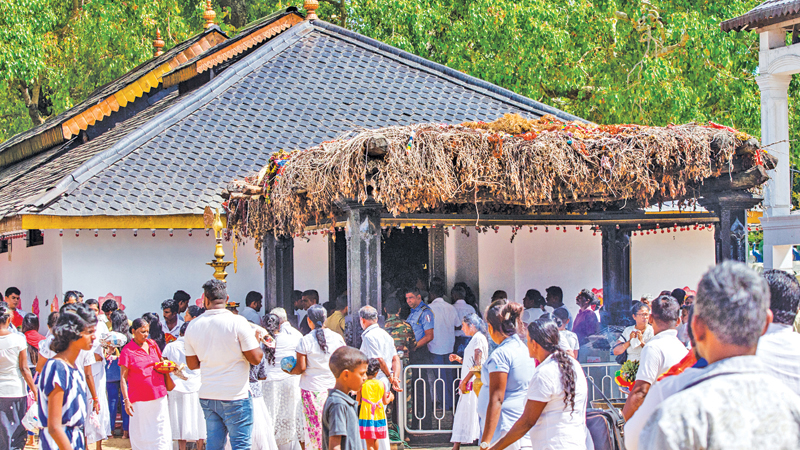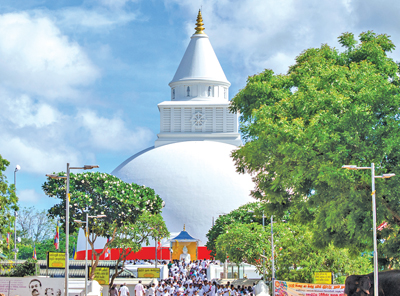From Kataragama to the land of Gods and legends-by MAHIL WIJESINGHE
Source:Sundayobserver
 In modern Sri Lanka, Tissamaharama and Kirinda carry far less importance to the average person than Kataragama. Author Paul Wirz called this jungle site on the Menik Ganga ‘the holiest place in Ceylon.’ Pilgrims from all religions flock to the shrines – about 21 kilometres from Tissamaharama – to worship and make offerings.
In modern Sri Lanka, Tissamaharama and Kirinda carry far less importance to the average person than Kataragama. Author Paul Wirz called this jungle site on the Menik Ganga ‘the holiest place in Ceylon.’ Pilgrims from all religions flock to the shrines – about 21 kilometres from Tissamaharama – to worship and make offerings.
The deity most often associated with Kataragama is Skanda, with six faces and 12 hands, known here simply as Kataragama Deviyo. Buddhists travel to Kataragama mainly to visit the Kirivehera, a great Dagaba one kilometre West of the main shrine where the Buddha is said to have sat in meditation on his third and final visit to Sri Lanka. The seven Hills of Kataragama rise four kilometres South of the holy shrines.
There are a number of mythical versions of God Skanda and many such tales have been woven around the origins of God Skanda in Hindu mythology. The fable, detailing one such strand is that God Skanda Kumar, the Hindu God of War, fell from Heaven into the ocean. From there, he was carried in a granite boat (gal oruwa) and it had landed in Dondra (Devundara), the ancient City of Gods.
He was armed with his weapon (audaya), the Vel/Swami). Since it was a fishing ground, and its smell was intolerable, he decided to leave the place. In selecting a permanent site for his abode, Skanda is said to have thrown his sacred Vel/Swami into the air, when it miraculously fell on the hill ranges of the Kataragama mountain frontier which became his permanent and sacred abode to this day.
Symbol of worship
Another part of legend is that God Skanda was born in the Himalayas and for 20 centuries had lived in South India where he was a symbol of worship and South Indians ultimately brought him there from the North. The same tale says that God Skanda landed at Munneswaram or Swami Rock in Fort Fredrick, Trincomalee.
As to the origin of the peacock which is God Skanda’s vehicle, the following story is told. As the Asura king was in the last stages of his life, he implored upon Skanda to be always near him. This dying Asura King’s last wish was fulfilled as he was transformed into a peacock for the vakanam of the God (a vehicle) and a cock for his standard.
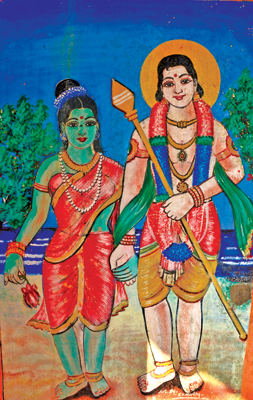
he other folklore connected with Valli, is while God Skanda was out hunting, he met this beautiful jungle belle – a Veddah girl named Valli. Though he fell head over heels in love with her, Valli did not acknowledge his amorous advances.
Thereafter, having apprised his brother Ganapathi (Ganesh-God of Wisdom), he devised the following ruse to win her. Ganesh told his brother Skanda that he would come in the guise of an elephant, whom she was mortally afraid of and gave him a pot of water to sprinkle over him which would enable Ganesh to regain his original form.
Skanda having gone there in the guise of a hermit met Valli whom he found eating some millet. When this food got choked, he offered her some water, but in his excitement, he trampled the pot of water and its contents spilt. At the very juncture of this mishap, Ganapathi appeared in the guise of a charging elephant, and the terrified Valli embraced Skanda in utter desperation for protection from the onslaught of this enraged elephant. Skanda told her if she consented to marry him, he can save her.
Having given her consent to marry him, in eternal joy, Skanda drove the elephant away, and took her away as his wife. Ever since that tragic error, they say that God Ganesh remained half human and half elephant (having an elephant head and a human body).Ever since Valli Amma’s romantic rendezvous with God Skanda, the Adhiwasi Aththo (Veddahs) came to worship Valli Amma and even now at Kataragama there lies the Valli Amma Kovil. In Bintenna Pattuwa, the home of the now extinct Veddahs, in time of festivals such as the Mahiyangana Perahera, the Veddahs worship Valli Amma at the Kovil there.
Separate Kovils
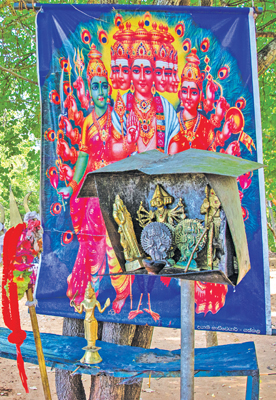
The God Skanda or Kataragama Deviyo represents six faces and 12 hands and his vehicle is a peacock
Later, it is said that Thevamman, Skanda’s first wife from India arrived in the company of Brahmin attendants and formed her abode at Kataragama, while Valli Amma lived in a separate apartment which was visited by God Skanda on the sly. Even today, the Thevamman Kovil and Valli Amma Kovil are housed separately at the Kataragama shrine. Sella Kataragama is the romantic spot where the love scene between Skanda and Valli Amma took place. Adjoining this is the shrine dedicated to God Ganesh who had played a prominent role in this tryst between Skanda and Valli Ammma.
Kataragama is better and popularly known as Veda Hitikanda, the holiest of the holiest hills of the seven holy hills embracing this shrine in the jungle, where God Kataragama had lived originally. During the festive season, a light is kept glowing all night there.
During the glorious rule of Prince Dutugemunu, before he launched the battle with Elara of Anuradhapura, it is said that a holy man had appeared in a dream who was no other person but God Skanda himself. Gemunu beseeched God Skanda’s aid to win his battle.
Then the God told him that he would plant his Vel/Swami, at the site of the present devale. Before Gemunu set out to Anuradhapura to meet King Elara, from Ruhunu Rata, he cut a few branches of a tree and planted them there and offered poojas. Thereafter, he resumed his march with his army to Anuradhapura to meet King Elara in the battle.
After Gemunu’s victory, the just and noble Prince fulfilled his vow, by building the present shrine and gifted lands to the shrine.
Then other version of this story is that Gemunu was warned in a dream not to fight Elara, until he sought the aid of the God Kataragama. It is said that he made a number of visits later, by offering poojas and even underwent severe penance invoking his blessings, when the God appeared to him in his dreams.
Unity in diversity
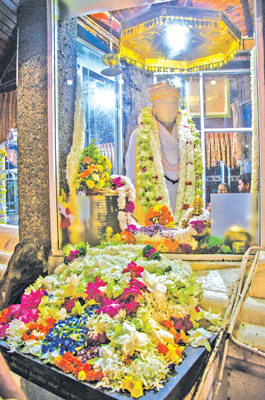
The stone statue of King Dutugemunu in the Kiri Vehera premises
Besides, the Sinhala and Hindu, the Muslims too worship at Kataragama as there is a separate shrine for them there. In the 1980’s, under the Gam Udawa program of President R. Premadasa, a facelift has been given to Kataragama. Popularly called the ‘Jungle Shrine’, thousands of pilgrims belonging to all religions, the Buddhists, Hindus, Muslims, even Christians, many foreigners, Swamis and free thinkers make their way to pay homage to Hindu God – Kataragama Deviyo. They even undergo severe penances such as physical inflictions to their flesh and body.
Within easy reach of the Kataragama Devale lies the magnificent Chaitya called Kiri Vehera. In chronicles, it is called Mangala Maha Seya of the ‘Kataragama Raja Maha Vihara’.
According to an inscription, it states that this Chaitya was repaired in the 2nd Century AD. In the chronicle of ‘Chulavamsa’, it is stated that King Dappula I, when he was the sub-king of Rohana, had built the Rohana Vihara. This Rohan Vihara is deemed to be the Kiri Vehera of Kataragama.
Kiri Vehera was restored many years ago. It looks a striking Vihara which in its creamy colour is in itself illuminating. In the premises of the Dagaba, are some standing stone pillars and a stone statue which is believed to be that of King Dutugemunu, now it is covered in a glass cubical. The Buddha when he visited Sri Lanka for the third time, is believed to have paid a brief visit on his way to Kelaniya, to this hallowed spot where the Kiri Vehera now stands. Another tradition says that Kiri Vehera was built by King Mahanaga of the 3rd Century BC.


